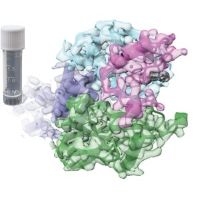Specification
| Uniprot ID | P31947 |
| Gene Names | SFN |
| Alternative Names | (Epithelial cell marker protein 1)(Stratifin) |
| Organism | Homo sapiens (Human) |
| Expression Host | E.coli |
| Tag Info | N-terminal 10xHis-tagged and C-terminal Myc-tagged |
| Molecular Weight | 32.8 kDa |
| Expression Region | Full Length(1-248aa ) |
| Expression Region | N-terminal 10xHis-tagged and C-terminal Myc-tagged(Full Length ) |
| Purity | Greater than 90% as determined by SDS-PAGE. |
| Endotoxin | Not test. |
| Form | Liquid or Lyophilized powder |
| Buffer | The default storage buffer is Tris/PBS-based buffer, 5%-50% glycerol if the delivery form is liquid. The lyophilization buffer is Tris/PBS-based buffer, 6% Trehalose, pH 8.0 if the delivery form is lyophilized powder. Please contact us if you have any special requirment. |
| Reconstitution | Please reconstitute protein in deionized sterile water and we recommend that briefly centrifuge thevial prior to opening the vial .We recommend aliquot for long-term storage at -20℃/-80℃. |
| Storage | Generally, the shelf life of liquid form is 6 months at -20℃/-80℃. The shelf life of lyophilized form is 12 months at -20℃/-80℃. The shelf life is related to many factors, storage state, buffer ingredients, storage temperature and the stability of the protein itself. |
| Protein Sequence | MERASLIQKAKLAEQAERYEDMAAFMKGAVEKGEELSCEERNLLSVAYKNVVGGQRAAWRVLSSIEQKSNEEGSEEKGPEVREYREKVETELQGVCDTVLGLLDSHLIKEAGDAESRVFYLKMKGDYYRYLAEVATGDDKKRIIDSARSAYQEAMDISKKEMPPTNPIRLGLALNFSVFHYEIANSPEEAISLAKTTFDEAMADLHTLSEDSYKDSTLIMQLLRDNLTLWTADNAGEEGGEAPQEPQS |
Background
| Research Areas | Neuroscience |
| Relevance | Adapter protein implicated in the regulation of a large spectrum of both general and specialized signaling pathways. Binds to a large number of partners, usually by recognition of a phosphoserine or phosphothreonine motif. Binding generally results in the modulation of the activity of the binding partner. When bound to KRT17, regulates protein synthesis and epithelial cell growth by stimulating Akt/mTOR pathway. May also regulate MDM2 autoubiquitination and degradation and thereby activate p53/TP53.; p53-regulated inhibitor of G2/M progression. |
QC Data
| Note | Please contact us for QC Data |
| Product Image (Reference Only) |  |

